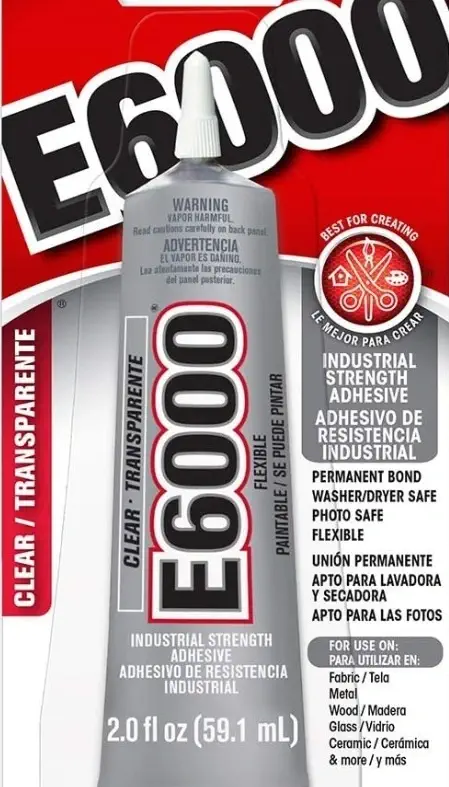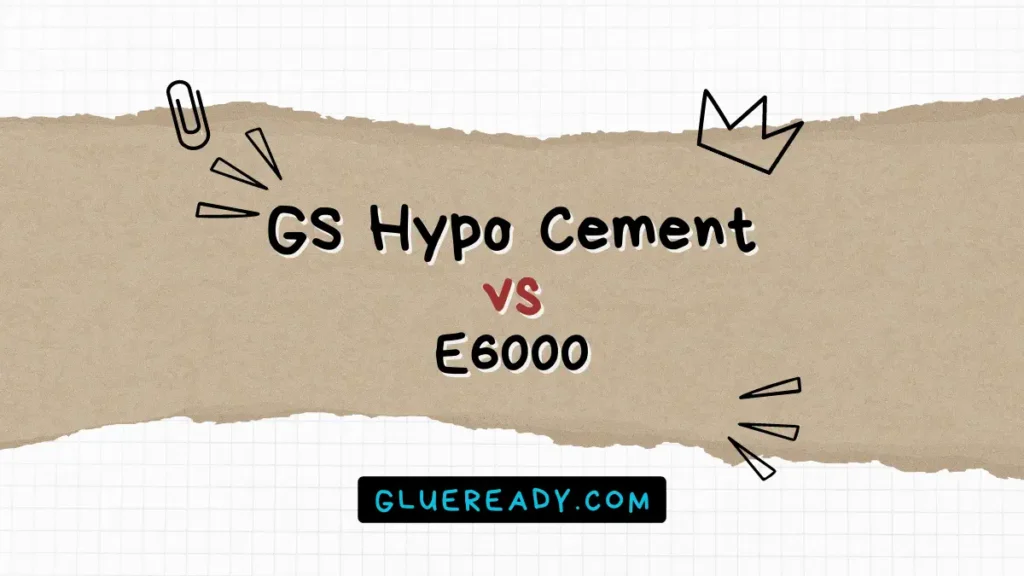E6000 vs Epoxy | In-Depth Analysis

Whether you’re an avid crafter or involved in industrial applications, understanding the differences between E6000 and epoxy can help you choose the right one.
Epoxy is usually stronger and cures faster, but E6000 glue is more flexible and versatile. Although epoxy is more chemical resistant, both can smell bad.
In this article, I will compare E6000 vs Epoxy to help you find the one you need the most.
Overview of E6000
E6000 is a high-grade polyurethane adhesive that has existed since the late ’80s. It is an industrial-strength adhesive that is clear, waterproof, and flexible.
It can bond to various materials, such as wood, metal, glass, ceramic, leather, rubber, plastic, and more. It is also resistant to chemicals, abrasion, UV rays, and temperature changes.
E6000 is ideal for projects requiring a strong and durable bond that can withstand stress and movement. It is also great for repairing or decorating items that have irregular shapes or surfaces.

Some examples of E6000 projects are:
- Fixing broken jewelry or accessories
- Attaching embellishments to clothing or shoes
- Sealing cracks or gaps in pipes or containers
- Mounting hooks or hangers to walls or ceilings
- Creating custom crafts or art pieces
Overview of Epoxy
In epoxy, resin is combined with a hardener to form a two-part adhesive. As soon as they are mixed together, a chemical reaction takes place, forming a hard and solid bond.
Epoxy can also bond to various materials, such as wood, metal, glass, ceramic, stone, concrete, and more. It is also water-resistant and heat-resistant.
Epoxy is ideal for projects that require a fast and strong bond that can fill gaps or cracks. It is also great for repairing or restoring items that have been damaged or worn out.

Some examples of epoxy projects are:
- Repairing broken pottery or glassware
- Filling holes or dents in wood or metal
- Coating surfaces with a glossy or protective layer
- Making molds or casts of objects
- Creating resin art or jewelry
E6000 vs Epoxy – Comparison Table
To help you compare E6000 vs epoxy more easily, here is a table that summarizes their main differences:
| Feature | E6000 | Epoxy |
| Base | Polyurethane | Resin and Hardener |
| Cure Time | 24 to 72 hours | 5 minutes to 24 hours |
| Flexibility | High | Low to medium |
| Gap Filling | Low | High |
| Odor | Strong | Moderate |
| Bond strength | 3500 psi | 1500 to 4500 psi |
| Chemical resistance | Moderate | High |
| Transparency | Clear | Clear or colored |
| Toxicity | High | Moderate |
| Paintability | Yes | Yes |
Which One to Choose? E6000 or Epoxy?
When deciding between E6000 and epoxy, consider the specific requirements of your project.
If you’re working on crafts, jewelry making, or general household repairs, E6000’s flexibility, versatility, and compatibility makes it an excellent choice.
Its ability to withstand vibrations and temperature fluctuations ensures a long-lasting bond.
Conversely, epoxy works best for heavy-duty applications that need strength and rigidity.
Its superior bonding capabilities and fast curing times make it suitable for industrial, commercial, and construction projects.
Both E6000 and epoxy adhesives should be handled with care.
E6000 has a strong smell and contains chemicals you shouldn’t inhale or ingest. It’s important to use it in well-ventilated areas and take necessary precautions.
Epoxy adhesives can also emit fumes during the curing process, and certain formulations may require additional safety measures.
Is E6000 Glue Better Than Epoxy?
There is no definitive answer to whether E6000 glue is better than epoxy, as it depends on the type of project you are working on and the preferences you have.
As I have discussed in the article, E6000 and epoxy have different features and benefits that make them more suitable for different situations.
For example, if you need a flexible and resilient bond that can adapt to changes in temperature, humidity, or movement, E6000 glue might be a better choice.
However, if you need a fast and strong bond that can fill gaps or cracks, epoxy might be a better choice.
Ultimately, the best way to find out which one is better for your project is to try them out yourself and see how they perform.
You can also read some reviews or watch some videos of other people who have used them for similar projects and learn from their experiences.
Why Use Epoxy Instead of Glue?
You might want to use epoxy instead of glue if you need a stronger, more durable, and more versatile adhesive.
Epoxy is a type of resin that cures chemically when mixed with a hardener. It can bond different types of materials, such as metal, wood, glass, plastic, and more.
It can also fill gaps, cracks, and holes, and can be sanded, drilled, and painted.
Glue is a general term for any substance that can stick things together. There are different types of glue, such as super glue, wood glue, contact cement, and more.
Each glue has its own properties and uses, but they are usually less strong and less resistant than epoxy. Glue also tends to dry by evaporation or exposure to air, which can make it less reliable over time.
Some examples of when you might want to use epoxy instead of glue are:
- When you need to bond materials that are subject to high stress, pressure, or temperature.
- When you need to create a waterproof or chemical-resistant seal or coating.
- When you need to repair or reconstruct damaged or broken parts.
- When you need to create a smooth and hard surface on wood or other materials.
Is Epoxy The Strongest Glue?
Epoxy glue is one of the strongest and most durable glues available in the market. It has a high tensile and shear strength, which means it can withstand pressure from any direction.
It can bond materials such as metal, ceramics, and glass, and it is resistant to water, heat, and most chemicals.
However, epoxy glue is not the strongest glue in every situation. It depends on the type of project and the material you are working with.
For example, epoxy glue may not be the best choice for flexible or porous materials, as it can crack or peel off over time.
Epoxy glue also requires mixing two components and working within a limited time before it hardens. This can make it difficult to apply or adjust the glue.
Therefore, epoxy glue is not necessarily the strongest glue for every project, but it is one of the strongest glues for heavy-duty and high-stress applications.
You should always consider the properties and requirements of your project before choosing a glue.
Read More: E6000 vs Gorilla Glue
Can You Use E6000 Instead of Resin?
No, you cannot use E6000 instead of resin. E6000 is a glue, not a resin. Resin is a liquid that hardens when it’s mixed with a catalyst or exposed to UV light.
E6000 is a polyurethane adhesive that bonds materials together, but does not form a solid by itself.
Read More: E6000 vs B7000
Final Thoughts
It is generally recommended to use E6000 for projects requiring flexibility, and epoxy for projects requiring strength.
While E6000’s flexibility and versatility make it a favorite among crafters, epoxy’s superior strength and rigidity make it indispensable for heavy-duty applications.
I hope this article has helped you compare E6000 vs Epoxy and decide which one is suitable for your project.






